Clemensodon is a genus of extinct mammal from the Upper Cretaceous of North America. It lived during the end of the Mesozoic, also known as the "age of the dinosaurs". It was a member of the extinct order of Multituberculata within the suborder of Cimolodonta and family Eucosmodontidae. Fossil remains are restricted to teeth.

Vegavis is a genus of extinct bird that lived during the Late Cretaceous of Antarctica, some 68 to 66 mya. Among modern birds, most studies show that Vegavis is most closely related to ducks and geese (Anatidae), but it is not considered to be a direct ancestor of them, although other studies question these results.
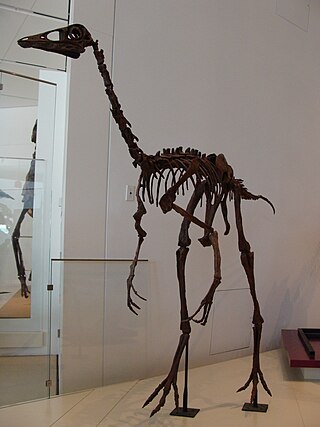
Ornithomimus is a genus of ornithomimid theropod dinosaurs from the Campanian and Maastrichtian ages of Late Cretaceous Western North America. Ornithomimus was a swift, bipedal dinosaur which fossil evidence indicates was covered in feathers and equipped with a small toothless beak that may indicate an omnivorous diet. It is usually classified into two species: the type species, Ornithomimus velox, and a referred species, Ornithomimus edmontonicus. O. velox was named in 1890 by Othniel Charles Marsh on the basis of a foot and partial hand from the Denver Formation of Colorado. Another seventeen species have been named since then, though almost all of them have been subsequently assigned to new genera or shown to be not directly related to Ornithomimus velox. The best material of species still considered part of the genus has been found in Alberta, representing the species O. edmontonicus, known from several skeletons from the Horseshoe Canyon Formation. Additional species and specimens from other formations are sometimes classified as Ornithomimus, such as Ornithomimus samueli from the earlier Dinosaur Park Formation.

Richardoestesia is a morphogenus of theropod dinosaur teeth, originally described from the Late Cretaceous of what is now Canada, the United States and Kazakhstan. It currently contains two species, R. gilmorei and R. isosceles, and a possible third, R. asiatica. It has been used as a morphotaxon to describe other theropod teeth widely displaced in time and space from the type species. If all teeth assigned to the genus are truly reflective of the animals biology and taxonomic state, it would have been one of the longest lasting dinosaur genera, perhaps also being the most widely distributed.

Avisaurus is a genus of enantiornithine bird from the Late Cretaceous of North America.
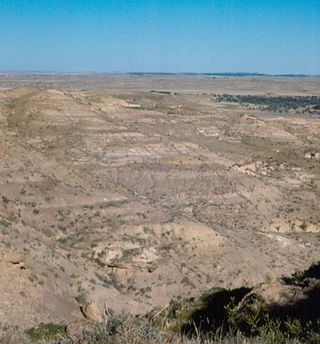
The Lance (Creek) Formation is a division of Late Cretaceous rocks in the western United States. Named after Lance Creek, Wyoming, the microvertebrate fossils and dinosaurs represent important components of the latest Mesozoic vertebrate faunas. The Lance Formation is Late Maastrichtian in age, and shares much fauna with the Hell Creek Formation of Montana and North Dakota, the Frenchman Formation of southwest Saskatchewan, and the lower part of the Scollard Formation of Alberta.

Quilmesaurus is a genus of carnivorous abelisaurid theropod dinosaur from the Patagonian Upper Cretaceous of Argentina. It was a member of Abelisauridae, closely related to genera such as Carnotaurus. The only known remains of this genus are leg bones which share certain similarities to a variety of abelisaurids. However, these bones lack unique features, which may render Quilmesaurus a nomen vanum.

Pectinodon is a genus of troodontid theropod dinosaurs from the end of the Maastrichtian age of the Late Cretaceous period (66 mya). It currently contains a single valid species, Pectinodon bakkeri, known only from teeth.
Torotix is a Late Cretaceous genus of aquatic birds. They lived along the shores of the Western Interior Seaway, but it is not clear whether they were seabirds or freshwater birds, as the genus is only known from a humerus. Consequently, the genus contains only one known species, Torotix clemensi. T. clemensi is represented by a single fossil specimen, a partial humerus recovered from the Lance formation of Wyoming. Its deposits are dated to the very end of the Cretaceous period, 66 million years ago.

Sinornis is a genus of enantiornithean birds from the Lower Cretaceous Jiufotang Formation of the People's Republic of China.
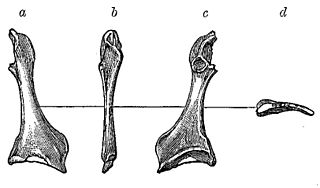
Cimolopteryx is a prehistoric bird genus from the Late Cretaceous Period. It is currently thought to contain only a single species, Cimolopteryx rara. The only specimen confidently attributed to C. rara was found in the Lance Formation of Wyoming, dating to the end of the Maastrichtian age, which ended about 66 million years ago. The dubious species "Cimolopteryx" maxima has been described from both the Lance Formation and the Hell Creek Formation of Montana. The humeral end of a left coracoid from the Frenchman Formation of southern Saskatchewan has also been attributed to the genus.
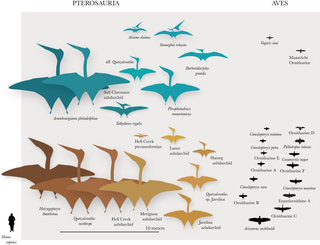
Ceramornis is a genus of ornithuran dinosaurs from the Late Cretaceous. It lived shortly before the Cretaceous–Paleogene extinction event in the Maastrichtian, some 66 million years ago (mya). Its remains were found in the Lull 2 location, a Lance Formation site in Niobrara County, Wyoming. A single species is known, Ceramornis major, and even that only from a proximal piece of coracoid. This is specimen UCMP V53957, which was collected by a University of California team in 1958.

Palintropus is a prehistoric bird genus from the Late Cretaceous. A single species has been named based on a proximal coracoid from the Lance Formation of Wyoming, dated to the latest Maastrichtian, 66 million years ago. Coracoids and a proximal scapula of two unnamed species from the upper Campanian Dinosaur Park Formation of Alberta, dating to between 76.5 and 75 million years ago, are also known.

Cimolopterygidae is an extinct family of ornithurine dinosaurs known from the Late Cretaceous epoch. Remains attributed to cimolopterygids have been found in the Frenchman Formation of Saskatchewan, the Lance Formation of Wyoming, the Fox Hills Formation of Colorado, the Hell Creek Formation of Montana, and the Allen Formation of Rio Negro, Argentina. Most date to the end of the Maastrichtian age, about 66 million years ago, though a much earlier species has also been identified from the Campanian-aged Dinosaur Park Formation of Alberta, about 75 million years ago.
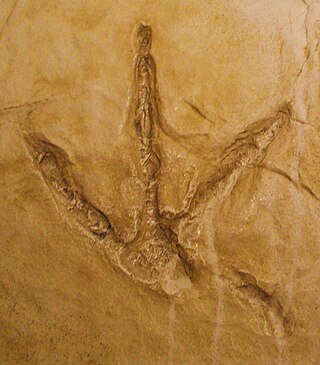
Saurexallopus is an ichnogenus of four-toed theropod footprints from the Late Cretaceous period. The type ichnospecies is S. lovei, named and described in 1996 from the Harebell Formation. The taxon was originally named Exallopus, but later renamed as Saurexallopus as the former was preoccupied by a polychaete. A second species, S.zerbsti, was named and described in 2004 from the Lance Formation. In 2012 a four-toed track from the Cantwell Formation was referred to Saurexallopus indet. It was also suggested that Saurexallopus was produced by a therizinosaur taxon. In 2013 based on skeletal proportions it was suggested that the ichnotaxon was instead produced by an oviraptorosaur taxon. In 2014 a third species was named, S.cordata, from the Wapiti Formation. In 2018 several tracks from the Blackhawk Formation were referred to Saurexallopus indet.
Elbretornis is an extinct genus of enantiornithine which existed in what is now Salta Province, Argentina during the late Cretaceous period.
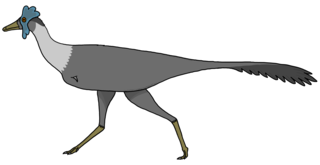
Bonapartenykus is a monospecific genus of alvarezsauroid dinosaur from Argentina that lived during the Late Cretaceous (Campanian-Maastrichtian) in what is now the upper Allen Formation of the Río Negro Province. The type and only species, Bonapartenykus ultimus, is known from a nearly articulated but partial skeleton that was found in close association to two incomplete eggs and several clusters of eggshells belonging to the oogenus Arriagadoolithus. Bonapartenykus was named in 2012 by Federico L. Agnolin, Jaime E. Powell, Fernando E. Novas and Martin Kundrát. Bonapartenykus has an estimated length of 2.5 m (8.2 ft) and weight of 72 kg (159 lb), making it the largest member of the clade Alvarezsauroidea.

Quetecsaurus is a genus of titanosaurian sauropod dinosaur known from the Late Cretaceous of the southern Mendoza Province, western Argentina. It contains a single species, Quetecsaurus rusconii.

Fukuipteryx is an extinct genus of basal avialan dinosaurs found in Early Cretaceous deposits from Japan's Kitadani Formation. It contains one species, Fukuipteryx prima.
Patagopelta is an extinct genus of ankylosaurian dinosaur from the Late Cretaceous Allen Formation of Argentina. The genus contains a single species, P. cristata, known from a partial skeleton. While originally described as a nodosaurine, later discoveries provided support for parankylosaurian affinities for the taxon. Patagopelta is a very small ankylosaur, comparable in size to the dwarf nodosaurid Struthiosaurus, about 2 m (6.6 ft) long.























